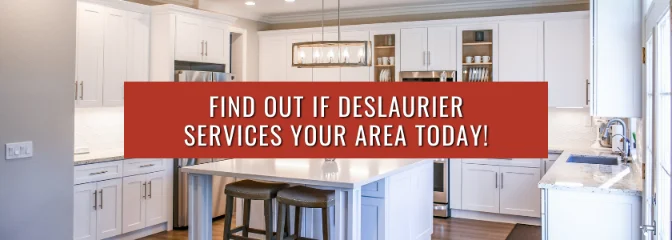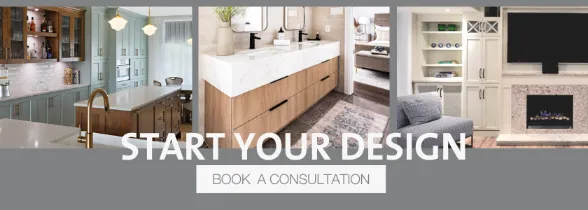24/02/2023 • Blog, Design Tips
6 Design Tips for Home Wall Units
Estimated Read Time: 5 Minutes
Built-in wall units have become more and more common since the turn of the century.
Nowadays, most new builds or home renovations will include built-in units, whether it’s the ultimate basement entertainment center or an elegant living room focal point.
At Deslaurier Custom Cabinets, we have over 40 years of experience manufacturing custom cabinets for kitchens, bathroom vanities, laundry rooms, and plenty of other custom millwork such as wall units.
With our years of experience in manufacturing custom cabinets and millwork, we've learned a thing or two about designing the perfect built-in wall unit.
Here are some tips and tricks from our expert design consultant Darien Wilson. Discover Darien's expertise and learn how to design the perfect home wall unit for your space!
|
Table of Contents |
|
TVs and Fireplaces Require an Electrician |
1. Include Plenty of Storage
You’ll never hear a homeowner complaining about having too much storage space.
Whether your built-in is in the basement or upstairs living room, you’ll want it to function as a design piece and a storage unit.
“My go-to is always 50-50 [storage and display]” - Deslaurier designer, Wilson states.
Base drawers are always great for hidden storage. They’re the perfect place to keep kids’ toys, board games, DVDs and other electronics.
All the things you’d find in a basement or living room that you want to keep out of sight when not being used.
It’s always nice to have full-height doors, as well. They help not only with storage capacity but also to keep any unsightly wires and cords tucked away.
2. Open Cabinets for Display
In terms of display, you’ll want some sort of shelving or open cabinets in your design.
This is where things like family pictures, cards, books, small plants, or other unique and aesthetic possessions will be presented.
In that sense, floating shelves are typically better left utilized in a kitchen, as they don’t offer the same support as cabinet boxes.
For built-ins, open cabinets are the way to go.
“It looks more “built-in” – everything looks like it's in the cabinets and there is barely any drywall to be seen.” - Wilson.
Open cabinets are essentially cabinets without doors. However, the interior of the box will be finished (painted or stained) to make them more visually appealing.
They offer shelving for display, while simultaneously keeping the unity of a wall unit – accentuating the appearance as one large custom “furniture” piece.
3. Choose Subtle Colours
When it comes to choosing colours for your wall unit, Wilson recommends working with subtle colours. Particularly in a living room near the kitchen, this isn’t where you want to make bold and daring choices.
Let other elements of the space be the eye-catching features. Whether that be the items on display, a large television or a luxurious fireplace (more on those below).
“I’m a huge fan of colour, and that’s the only place where I’d lean against it.” - Wilson.
You want the colour of your design to blend in with the rest of the space. Whether you match the kitchen or choose a simpler, more neutral colour.
You can also blend it with your chosen room’s wall paint. This doesn’t mean making it the same exact colour, but if you have white or off-white wall paint, using soft and subtle tones is a great way to make everything fit together seamlessly.
4. TVs and Fireplaces Require an Electrician
Most wall unit designs will be built around a focal point such as a television or fireplace (or both). However, if you plan on including a television or fireplace in your built-in, there are certain things you need to consider during the design process.
It’s crucial to know you will need to be working with a licensed electrician if your wall unit is accompanied by a television or a fireplace.
If you’re working with a Contractor on your renovation or a Builder on your new home, they will hire an electrician for you.
If you’re embarking on this journey yourself, that will be up to you to organize; as cabinet companies such as ourselves do not provide electrical services.
5. Mantle or No Mantle?
If your wall unit does include a fireplace, a key design choice will be whether you want to include a mantle or not.
“It is nice to leave a mantle because most of the time that’s where people want to hang their stockings” - Wilson.
A mantle can be a nice decorative element to add, especially if you include the beauty of natural wood.
If you do plan on having a mantle then there will be quite a bit of width on the side. It’s important to make sure your cabinets start after that or cabinet doors will be opened against the protruding mantlepiece.
If you’re after a modern design, consider opting for some millwork as opposed to a traditional mantle to create a streamlined look. Using the same material as the rest of the wall unit will help achieve a cohesive and modern aesthetic.
The same rule applies if your wall unit design has any “countertop” surfaces. Sticking with the same colour and material as the cabinetry will create a sleek and seamless appearance.
6. Don’t Get Ahead of Your Budget
No matter the room or project, the cost is always a main concern in a new build or renovation.
A wall unit is no different. In fact, most homeowners are surprised by how expensive their built-in design ends up being.
“Wall units are almost always more expensive than people think.” - Wilson.
Cabinets can be quite expensive; whether in your kitchen, bathroom, or a wall unit. Not to mention the additional costs that come with cabinets that have finished sides or end panels (which a built-in will need unless it covers the entire wall). Open cabinets, as well, will have finished interiors that increase costs.
Wall units can be between $10k-$20k for a standard built-in. Of course, the price will fluctuate depending on how large your wall unit design is and the materials you select for it.
Add in something like a stone or tiled fireplace and it’s easy to see how your budget can become stretched.
All of this to say: don’t get ahead of your budget. It’s typically safe to assume a custom built-in will be more expensive than your initial expectation.
Design with Deslaurier Custom Cabinets
We understand that deciding on wall units for your newly built or renovated home can be overwhelming. It's important to keep in mind storage, style, and cost before committing to the project. We hope our design expert, Darien Wilson, provided a bit more clarity and guidance for your upcoming project.
If you’re planning on upgrading your home with a built-in wall unit, Deslaurier Custom Cabinets has everything you need!
Book a consultation today with a Deslaurier design expert at our Jupiter, Florida Showroom or schedule a virtual meeting!
Interested in becoming an authorized Deslaurier dealer? Visit our Become a Dealer page to learn more! Live outside the area? Find a Dealer to connect with a Deslaurier dealer near you!

